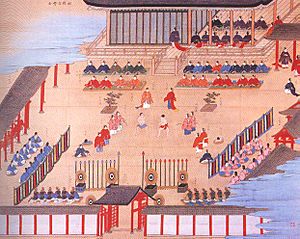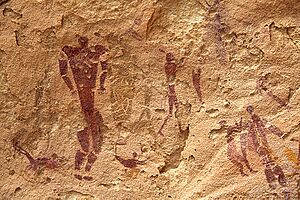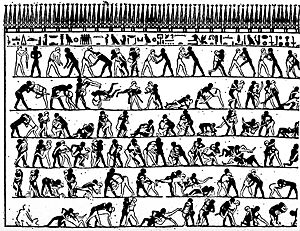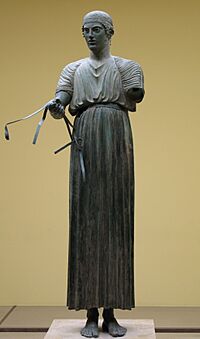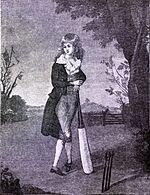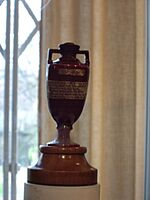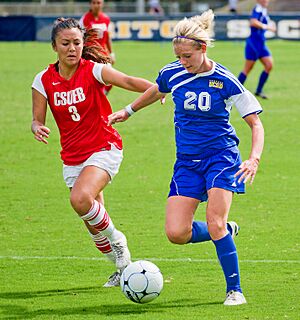History of sport facts for kids
The history of sports goes way back to ancient times, even before 7000 BCE. The physical activities that grew into sports were often connected to fighting in wars and to entertainment.
Learning about the history of sports can teach us a lot about how societies change. It also shows us how important sports are to humans, as they help us develop basic skills, much like playing does. The further back we go in history, the harder it is to find clear proof of how sports started and why people played them.
From the very beginning, sports were linked to military training. For example, competitions helped decide if people were strong and useful for serving in the army. Team sports were used to train soldiers and show they could fight well together as a group.
Contents
Sports in Early History
Some cave paintings in France, from about 15,300 years ago, seem to show people running and wrestling. In Mongolia, cave paintings from around 7000 BCE show a wrestling match with crowds watching. Rock art in Egypt, from about 10,000 BCE, shows people swimming and using bows and arrows. Even in Japan, very old cave paintings show a sport similar to sumo wrestling.
Sports in Ancient Sumer
Ancient Sumer, a civilization in what is now Iraq, has many carvings of wrestlers. One carving from about 3000 BCE shows three pairs of wrestlers. A bronze statue from around 2600 BCE shows two figures in a wrestling hold. This statue is one of the oldest pictures of sports ever found.
People in Sumer also seemed to enjoy boxing. The famous story of Gilgamesh, written around 2000 BCE, talks about Gilgamesh wrestling with Enkidu. Fishing hooks, much like the ones we use today, were found in Sumer from about 2600 BCE, suggesting people enjoyed fishing back then.
Ancient Egyptian Sports
In Ancient Egypt, drawings in tombs from around 2000 BCE show many sports. These included wrestling, weightlifting, long jump, swimming, rowing, archery, fishing, and various ball games. These sports were well-organized. Other Egyptian sports were javelin throwing and high jump. Even older drawings from about 2400 BCE show people wrestling.
Sports in Ancient Greece
The Minoan people of ancient Crete, around 1500 BCE, had ritual sports like bull-leaping. This was a form of gymnastics. Greek sports festivals might have started with funeral games, held to honor dead warriors. The famous Greek poem, the Iliad, describes these games in detail.
Sports were seen as something noble and wealthy people did. The first Olympic Games were held in Greece in 776 BCE. They happened every four years until 393 CE. These games started with just one running event. Over time, they added more footraces, boxing, wrestling, chariot racing, long jump, javelin throw, and discus throw.
During the Olympics, a special truce was called. This allowed athletes to travel safely to the games. Winners received wreaths made of laurel leaves. Other important Greek games included the Isthmian, Nemean, and Pythian Games. These, along with the Olympics, were the most important games. The Heraean Games, held as early as the 6th century BCE, were the first recorded sports competition for women.
Ancient Sports Around the World
Many sports are thousands of years old. Hurling in Ireland, shinty in Scotland, and harpastum (like rugby) in Rome are all very old. Cuju (like soccer) in China and polo in Persia also have long histories. The Mesoamerican ballgame started over 3,000 years ago. The Mayan ballgame of Pitz is thought to be the first ball sport, played around 2500 BCE.
Ancient China also had sports like gymnastics around 2000 BCE. In Persia, traditional martial arts like Zourkhaneh were practiced. Polo and jousting also came from Persia. In India, traditional sports like kho-kho, kabaddi, and atya-patya are thousands of years old.
Sports in the Middle Ages
For centuries, villages in England and Ireland played rough, sometimes violent, ballgames like Shrovetide football and caid. In Italy, combat sports like fencing and jousting were popular. Horse racing was a favorite sport among the rich in Great Britain.
During long summer days, peasants had free time for sports. Swimming, wrestling, and racing were common for all ages. Organized ball games were found in every medieval society. Kings in England tried to ban ball games like football and hurling many times.
After the Roman Empire fell, gladiatorial fights and chariot racing slowly disappeared. They were replaced by local activities. Falconry, however, was a sport enjoyed by emperors and kings. Tournaments were also common. These events, like jousting and mock combat, were seen as military training. However, some historians now believe they were mostly for entertainment.
Tournaments often happened during local festivals. They attracted many people for various reasons, including trade and even finding marriage partners. Knights who were good at tournaments became famous, much like sports stars today. They could earn money and property.
Sébastien Nadot, a historian, says that sports already existed in the 15th century. He notes that knights from different European countries shared the same rules and customs in tournaments. This "chivalrous international" shared ideas like fair play, honor, and loyalty. Owning a horse was also very important for the ruling class, as it allowed them to participate in sports like horse racing.
Sports in the Renaissance
After the Middle Ages, sports became less about war training and more about fun and exercise in Europe. During the Renaissance, teachers and doctors said that playing sports was good for both the body and mind. They believed sports should be for leisure, not just strict training.
Outdoor sports events became popular for everyone, no matter their social class. These new ideas about sports appeared in books and became part of society. As sports grew in popularity, rules were created to make them fair. Sports clubs also became common, especially for elite sports like horse racing, cockfighting, hunting, and tennis. For example, King Charles II made 20 rules for horse racing in 1665. Sports also became a form of entertainment for people who just watched. These new ideas about sports spread from Europe to Asia, Africa, and Latin America.
How Modern Sports Developed
Many historians believe that team sports, as we know them today, mostly started in Western cultures, especially Britain. British Prime Minister John Major once said that Britain invented most of the world's great sports.
British influence helped spread games like cricket, different types of football (soccer), bowling, billiards, field hockey, tennis, and winter sports around the world. This happened as the British Empire grew. The modern Olympic Games, which started in Europe, also helped make rules for similar games the same everywhere.
The Industrial Revolution brought more free time and allowed more people to play or watch sports. With mass media and global communication, professional sports became very popular.
As winning became more important, some people started to cheat. Using performance-enhancing drugs, like steroids, is a common way to cheat today. Agencies now monitor athletes to ensure fair play.
Sports in England
In England, cricket was influenced by historical events. After the English Civil War, when the monarchy returned in 1660, gambling became very popular. Cricket, horse racing, and boxing were often funded by gamblers. Rich cricket fans would form strong teams to represent their interests. Before 1660, cricket was mostly played by village teams. After that, professional teams started to form, marking the beginning of major cricket.
Many famous English schools, like Winchester and Eton, created their own versions of football and other sports. These were seen as "innocent and lawful" compared to rougher village games. As cities grew in the 19th century, these school rules spread. Governing bodies were set up in England for many sports by the late 1800s. The upper classes also emphasized "fair play" and amateur sports. The Industrial Revolution also made it easier for universities to compete, which led to efforts to unify game rules. This led to the creation of the Football Association in London, the first official football governing body.
Coaching also became a profession in the Victorian Era. During World War I, military groups hired coaches to help soldiers stay fit and build team spirit. Sports became a key part of military life for British soldiers worldwide.
British Empire and Sports Today
British sports and their rules spread globally in the late 1800s and early 1900s, especially soccer. Many famous teams around the world still show their British roots in their names. Cricket became popular in countries that were part of the British Empire, like Australia, India, and Pakistan. The modern Olympic Games were also greatly influenced by the amateur spirit of English schools. The British helped define amateurism, professionalism, tournament systems, and fair play.
Some sports that started in England became more popular in other countries than in England itself. Bandy, for example, is still popular in Finland, Russia, and Sweden.
European ideas about empires also shaped sports. Concepts like "social discipline" and "loyalty" from European empires were transferred to sports. Ideas of "patient and methodical training" helped make both soldiers and athletes stronger. Sports like baseball, soccer, and cricket all came from European influence and share similar values.
Baseball, which is related to English rounders, became popular in the northeastern United States. American football became popular in the southeast. There is evidence that baseball was played in England much earlier than thought. An 18th-century diary mentions playing "base ball" in England in 1755. In the 1870s, baseball split into professional and amateur leagues, with professional baseball quickly becoming dominant.
American football also came from English versions of the game. Early rules were based on the Football Association rules in London. However, Harvard chose to play a game based on Rugby football rules. Later, Walter Camp changed these rules a lot in the 1880s, which also influenced Canadian football rules.
The invention of the first lawn mower in 1830 was a big step for sports. It allowed for the creation of modern grass fields and courts for many sports, like football and tennis.
Sports in the United States
Most sports in the United States came from European traditions. However, basketball, volleyball, skateboarding, and snowboarding were invented in North America. Some of these have become popular worldwide. Lacrosse and surfing came from Native American and Native Hawaiian activities that existed before Europeans arrived.
Sports Around the World Today
In the 21st century, adventure sports have become popular. These sports, like white water rafting, paragliding, and base jumping, offer a way for people to escape everyday routines and seek excitement.
Women in Sports History
In the past, many societies did not encourage women to compete in sports. The way organized sports developed in English schools in the 1800s often discouraged women. For example, no women officially competed in the 1896 Olympic Games.
However, the 20th century saw big changes. Women's participation in sports grew a lot, especially in Europe and North America. This led to the creation of events like the Women's Olympiad (held in 1921, 1922, 1923) and the Women's World Games (held in 1922, 1926, 1930, 1934). The women's rights movement also helped increase girls' and women's involvement in sports. In the United States, a law called Title IX in 1972 greatly boosted female student participation. This law stopped gender discrimination in schools that received federal money, leading to more funding for female athletes.
Sports organizations also pushed for more equality. For example, the Marylebone Cricket Club and the Leander Club (for rowing) in England had only male members for a long time. But they started allowing women members at the end of the 20th century, partly because of funding requirements.
In the 21st century, women's participation in sports is at its highest ever. At the 2008 Summer Olympics, women competed in 27 sports. Many professional women's sports leagues have been created, and international events like the FIFA Women's World Cup continue to grow.
Stadiums Through Time
See also
- History of sports in the United Kingdom
- Sport in England
- History of physical training and fitness
- History of sport in Australia
- History of sports in Canada
- History of sport in the United States
- Nationalism and sport
- Sociology of sport


